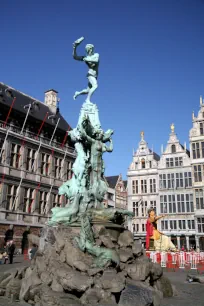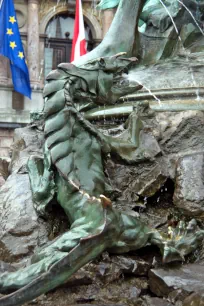The monumental fountain in front of the city hall depicts the legendary hero Brabo after his defeat of the giant Antigoon. The fountain was sculpted at the end of the nineteenth century by local artist Jef Lambeaux.
A legend, probably created in the Middle Ages, tells the story of the Roman hero Brabo and how he slayed the giant Antigoon.



The legend of Brabo
More than two thousand years ago, when Antwerp was just a small settlement in the Roman Empire, Druon Antigoon – a giant from Russian descent – built a large castle along the river Scheldt. He exacted a toll from every passing ship that sailed down the river. The giant cut off the hands of sailors who were unable or unwilling to hand over half of their cargo, and threw their hands in the river.
One day, the Roman soldier Silvius Brabo sailed along the giant’s castle. He refused to pay the toll and challenged Antigoon to a duel. Brabo managed to defeat the giant, cut off his head and hand and threw the hand in the river.
The Hand
According to popular etymology, the city’s name – Antwerpen – is derived from the act of Brabo throwing the hand (‘handwerpen’ in Flemish). The hand symbolizes the free waterway, which was vital for the city’s survival. The hand also became a symbol of Antwerp and appeared on city seals as early as in the thirteenth century. Even today it is prominently visible in the city: the hand is displayed on the city’s coat of arms and a local delicacy, known as ‘handje’ is shaped like a hand.
The Fountain
In the nineteenth century, when romanticism generated new interest in the city’s history, the idea was launched to create a monumental fountain depicting the heroic deed of Silvius Brabo. The legend of Brabo had become even more symbolic than ever before, since the Dutch had closed the river Scheldt in 1585, exacting a toll from any passing boat, which resulted in the city’s downfall from one of the world’s largest and most powerful cities to a middle-sized city. In 1863 the Dutch finally stopped demanding toll from passing ships and the city started to grow again.
In 1883 local sculptor Jef Lambeaux presented the city council with a design for a new fountain which celebrated the freeing of the river. Four years later, in 1887, the fountain was inaugurated amid great public interest. It was installed at the center of the Grote Markt, right in front of the City Hall.
The fountain depicts Brabo throwing the giant’s hand in the river. Brabo stands on a tall pedestal decorated with water spouting sea animals – a fish, a sea lion, a turtle and a dragon-like monster. Mermaids support a castle, symbolizing the city. Giant Antigoon’s head dangles just below Brabo’s feet.

More Brabo
The statue that crowns the fountain is the largest, but far from the only statue of Brabo in the city. Just a stone’s throw away, at Handschoenmarkt – the square right in front of the cathedral – is another, much older sculpture of Brabo. It was created as early as in 1490 by local artist Quentin Matsys as part of his elaborate wrought-iron decoration that crowns the square’s well.

The facade of the city hall also featured a statue of Brabo. Unfortunately, when the Catholic Spanish invaders occupied the city in 1585 they removed the statue and replaced it with a statue of Mary. The statue of Brabo moved to the top of a gate known as Werfpoort, which was demolished in 1810 under French occupation.
Another statue of Brabo can be found in Zurenborg, on a balustrade of a house aptly named «Brabo», at Cogels-Osylei 1. This rather large statue was created by local sculptor Jules Weyns around 1896 and shows the hero clad in medieval armor. The same sculptor created another Brabo statue that stand at the top of the so-called ‘Loodswezen’, an eclectic building from 1895 near the waterfront.
- Next: MAS
- More Sights & Attractions in Antwerp

